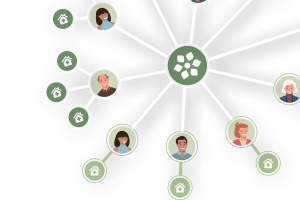CLL Patient Mental Wellness: Grounding Technique

CLL patients may be overwhelmed by many difficult emotions related to the disease diagnosis, treatment, or just everyday life. These emotions can often pull us out of the present moment, immersing us in past memories, future anxieties, create feelings of detachment, and disconnection from our current environment.
To navigate these challenging emotions, the grounding technique offers an effective way to re-anchor oneself in the "here and now." This helps pull us out of spirals of overwhelming emotion and return to the present.
The key to successfully implementing grounding is awareness. Recognizing when we have mentally checked out is the first step. Once we identify that we are detached from the present, often as a defense mechanism against painful realities, we can choose to ground ourselves.
A Four-Step Grounding Technique
- Step One: Visual Connection
- Begin by focusing on your surroundings. Take in the details - the color, shape, and position of objects around you. Spend about 5 minutes on this step. For example, one might observe, "The red curtains sway gently with the breeze, revealing a blue sky outside. My drink cup to my left has steam floating from it."
- Step Two: Mindful Breathing
- Shift your attention to your breathing. Feel the gentle ebb and flow of your breath. Aim to spend about five minutes on this, breathing deeply and slowly at first in through the nose and out through the mouth, then transitioning to your natural rhythm.
- Step Three: Physical Awareness
- Turn your focus to the sensations of your body. Feel the weight of your body on the chair, the touch of your feet on the floor, and any tension or relaxation in other areas of your body. Spend about five minutes on this step.
- Step Four: Engage Other Senses
- Finally, tap into your other senses. What scents do you smell? What sounds, near or far, do you hear? Spend about five minutes on this step.
Once patients practice the above grounding technique until it becomes a familiar habit, they will have a valuable emotional resilience tool to draw upon when depression or anxiety tries and pull them out of the present moment. Help stop emotional spirals and protect your mental well-being. Patients are welcome to shorten or lengthen the amount of time of each step as they see fit.
If patients need further help to support their emotional well-being, reaching out to a licensed mental health counselor is always a good option. We encourage you to take the needed steps to improve your mental health to better your quality of life.
CLL patients may be overwhelmed by many difficult emotions related to the disease diagnosis, treatment, or just everyday life. These emotions can often pull us out of the present moment, immersing us in past memories, future anxieties, create feelings of detachment, and disconnection from our current environment.
To navigate these challenging emotions, the grounding technique offers an effective way to re-anchor oneself in the "here and now." This helps pull us out of spirals of overwhelming emotion and return to the present.
The key to successfully implementing grounding is awareness. Recognizing when we have mentally checked out is the first step. Once we identify that we are detached from the present, often as a defense mechanism against painful realities, we can choose to ground ourselves.
A Four-Step Grounding Technique
- Step One: Visual Connection
- Begin by focusing on your surroundings. Take in the details - the color, shape, and position of objects around you. Spend about 5 minutes on this step. For example, one might observe, "The red curtains sway gently with the breeze, revealing a blue sky outside. My drink cup to my left has steam floating from it."
- Step Two: Mindful Breathing
- Shift your attention to your breathing. Feel the gentle ebb and flow of your breath. Aim to spend about five minutes on this, breathing deeply and slowly at first in through the nose and out through the mouth, then transitioning to your natural rhythm.
- Step Three: Physical Awareness
- Turn your focus to the sensations of your body. Feel the weight of your body on the chair, the touch of your feet on the floor, and any tension or relaxation in other areas of your body. Spend about five minutes on this step.
- Step Four: Engage Other Senses
- Finally, tap into your other senses. What scents do you smell? What sounds, near or far, do you hear? Spend about five minutes on this step.
Once patients practice the above grounding technique until it becomes a familiar habit, they will have a valuable emotional resilience tool to draw upon when depression or anxiety tries and pull them out of the present moment. Help stop emotional spirals and protect your mental well-being. Patients are welcome to shorten or lengthen the amount of time of each step as they see fit.
If patients need further help to support their emotional well-being, reaching out to a licensed mental health counselor is always a good option. We encourage you to take the needed steps to improve your mental health to better your quality of life.

about the author
Megan Heaps
Megan joined HealthTree in 2022. She enjoys helping patients and their care partners understand the various aspects of the cancer. This understanding enables them to better advocate for themselves and improve their treatment outcomes.
More on Navigating Your Health
Trending Articles

Get the Latest Chronic Lymphocytic Leukemia Updates, Delivered to You.
By subscribing to the HealthTree newsletter, you'll receive the latest research, treatment updates, and expert insights to help you navigate your health.













